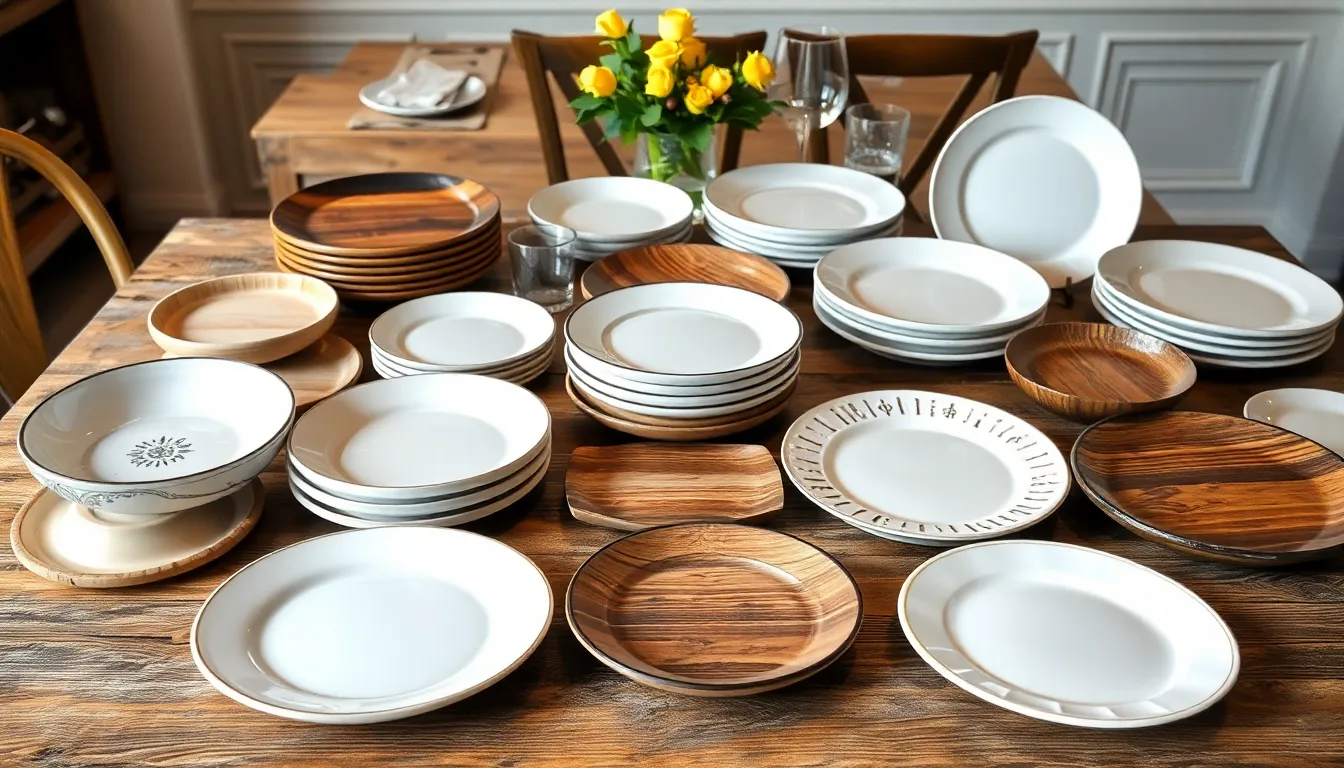Table of Contents
ToggleWhen it comes to dining, the plate is the unsung hero of every meal. It’s not just a flat surface for food; it’s a canvas for culinary creativity and the ultimate stage for your gastronomic masterpieces. Think about it—without a plate, your spaghetti would be a sad puddle on the table, and that gourmet burger? Well, it’d just be a messy hand-held disaster.
The Importance of A Plate On Which Food Is Eaten
A plate significantly enhances the dining experience by providing an organized space for food. Presentation matters; a plate transforms a simple meal into an appealing feast. Vibrant colors and textures contrast beautifully against the background of a plate, drawing attention to the dish.
Utility extends beyond aesthetics; plates serve a functional purpose. Different types of plates cater to various cuisines and serving styles. For instance, flat plates are ideal for main courses, while bowls suit soups and salads. Heightened presentation often encourages appreciation of the meal’s flavors.
Cultural significance cannot be overlooked when discussing the importance of plates. Various cultures employ unique plating techniques, reflecting traditions and values. Traditional Japanese cuisine, for example, utilizes specific dishware to enhance the overall dining experience.
Using the right plate can elevate even the most basic foods. A gourmet burger on a decorative plate creates a sense of indulgence. Quality plates also influence portion control, guiding diners in making healthier choices.
Versatility plays a key role in the importance of plates. They transition seamlessly between casual and formal settings. Different materials, such as porcelain, ceramic, or bamboo, cater to specific occasions.
A plate’s shape and size directly affect the dining experience. Deep plates work well for saucy dishes, while shallow plates suit dry meals. Customization offers unique opportunities to showcase personal style and flair.
A plate on which food is eaten shapes both the visual and functional aspects of dining. It fosters creativity and supports cultural expression, making each meal memorable.
Types of Plates

Plates come in various forms, each serving specific purposes and enhancing different dining experiences. Understanding the types of plates helps one choose the right option for any meal or occasion.
Material Choices
Ceramic plates provide durability and aesthetic appeal. Glass plates showcase vibrant colors and designs, allowing for elegant presentations. Melamine plates, known for their lightweight and shatter-resistant properties, cater to outdoor and casual settings. Wooden plates add a rustic touch, often used for artisanal and organic meals. Stainless steel plates offer resilience and ease of cleaning, ideal for certain cuisines. Each material offers distinct advantages, catering to different dining environments and aesthetic preferences.
Shape and Size Variations
Round plates dominate the dining scene, offering versatility for main courses and appetizers. Square plates introduce a modern twist, perfect for artistic food presentations. Oval plates serve large portions and family-style meals, enhancing communal dining experiences. Plates range from small dessert plates to large serving platters, accommodating various food types and portion sizes. Choosing the right shape and size plays a crucial role in the visual appeal and functionality of a meal, enhancing overall enjoyment.
Cultural Significance of Plates
Plates hold significant cultural value worldwide. They serve as more than just meal holders; they embody traditions and social norms tied to dining practices.
Plates in Different Cultures
Culinary customs vary across cultures, and each often uses specific plate types. For instance, Japanese cuisine favors deep dishes for sushi, while traditional Indian meals often involve thalis that showcase an array of dishes. Mexican culture employs colorful, hand-painted ceramics, adding vibrancy to meals. In contrast, Western settings frequently utilize simple white plates, emphasizing the food’s visual appeal. These choices reflect not only aesthetic preferences but also the intent behind food presentation in different societies.
Traditional Uses and Customs
Traditional uses of plates reveal much about social customs. In many cultures, communal eating encourages sharing food from a central plate. For example, Middle Eastern traditions involve using large platters for dishes like pilaf. In Italian family gatherings, sharing pasta from a single large bowl fosters unity. Ceremonial uses also exist, where specific plate types signify special occasions, such as ornate chargers for formal dinners. This illustrates how plates connect people and enrich cultural experiences through shared culinary practices.
Practical Considerations
Selecting the right plate significantly affects the dining experience. Plate choices vary based on meal types, serving styles, and cultural significance. Considerations include material, shape, and size. Ceramic plates withstand regular use, while elegant glass enhances presentation. Melamine suits casual gatherings, and wooden plates bring a rustic feel. Square plates offer a contemporary look, while round ones provide versatility. Choosing an appropriate size also promotes portion control, ensuring meals appear balanced and visually appealing.
Proper care and maintenance prolong a plate’s lifespan and maintain its aesthetic. Washing ceramic and glass plates by hand with mild soap preserves their finishes. Avoiding abrasive cleaners protects their surfaces. For melamine, use soft materials to prevent scratching. Wooden plates require oil treatments to prevent drying and cracking. Storing plates carefully prevents chipping and damage. Regular inspections for wear help retain their functional beauty, ensuring they remain suitable for any dining occasion.
Plates are more than just functional items; they play a vital role in the dining experience. Their design and material can significantly influence how food is perceived and enjoyed. By choosing the right plate, one can enhance not only the visual appeal of a meal but also its cultural significance.
From casual gatherings to formal occasions, plates provide a canvas for creativity and expression. They foster connections through shared meals and reflect the rich tapestry of culinary traditions. Ultimately, a well-chosen plate elevates the dining experience, making each meal not just a necessity but a memorable occasion.







